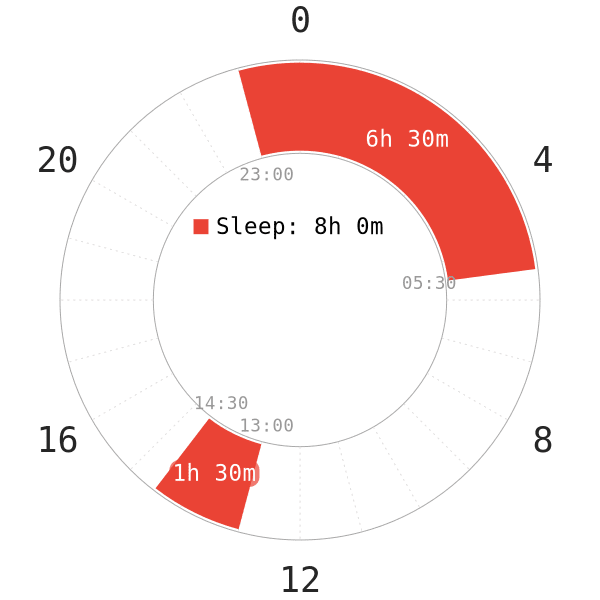Introduction
The term “hypersomnia” is usually an umbrella-term for all cases with or without excessive sleep duration1; nevertheless, it is also typical for “sleep drunkenness'” and excessive daytime sleepiness2,3. Hypersomniacs often have great troubles waking up in the morning, with crippling sleep inertia, and struggle to stay awake in the day.
Over the years, there have been a couple hypersomniac sleepers who join our community. Even though the success rate for polyphasic sleep remains very humble, we would want to explore the behavior of this medical condition further. Ultimately, we hope that there can be some ways that polyphasic sleeping can be natural for some fortunate cases.
Classification of Hypersomnia

Overall, hypersomnia is a destructive sleep disorder and often mistaken for narcolepsy; however, with the exception of cataplexy in narcolepsy, hypersomniac individuals often have long, unrestful daytime naps2. While narcoleptic individuals often only have short daytime naps (~20m long), hypersomniac equivalents can naturally sleep longer than 60 minutes.
In addition, hypersomnia also simply means long sleep duration, even temporarily. For example, exercising intensely or skipping sleep for a few days could trigger a surge of extended sleep duration, which would still be a form of hypersomnia. Still, to get the official diagnosis of chronic hypersomnia, the symptoms (long sleep durations or excessive daytime sleepiness) should have persisted for at least 3 months1.
Hypersomnia consists of two main categories:
- Primary hypersomnia can be prevalent in narcolepsy and idiopathic hypersomnia. It is also a visible symptom without other disorders.
- Secondary hypersomnia is a product of another disorder. Examples include clinical depression, obesity, sleep apnea and some medications’ effects.
As said earlier, not all hypersomniacs have excessively long sleep duration4.
- Most types of hypersomnia are incurable and require clinical examination.
- Fortunately, the sleep deprivation-hypersomnia type is only temporary and will subside after recovering.
- Treatments for chronic hypersomnia frequently involves pharmaceutical intervention from stimulants or anti-depressants.
As the main topic of this post, we will focus on the classic “Idiopathic hypersomnia“.
Sleep Characteristics of Hypersomnia
Although the findings may remain controversial, there are some results that may be useful to know3.
- Patients without long sleep time have less sleep inertia upon awakening in the morning than those with excessive total sleep.
- The normal-sleep-duration group has less SWS and REM sleep duration than the excessive-sleep-total group. However, the difference is not too significant.
- The group with long sleep duration spent more than 10 hours in bed per night and had delayed SWS latency.
- Daytime sleep was not very different between these two patient groups.
- Both of these groups had a higher REM and SWS baselines than the healthy group.
- Considering the daytime nap(s), hypersomniacs of both groups had much higher light sleep and REM duration per total sleep than the healthy participants.
Polyphasic Sleep Suitability
People who suffer from hypersomnia can still sleep polyphasically. As a matter of fact, a lot of them already require daytime naps to boost alertness and performance. Nonetheless, the standard schedules will likely contain too little sleep for them.
- First and foremost, they have to factor elevated SWS and/or REM needs into scheduling a sleep pattern. Ultimately, they most likely need to do extended schedules.
- If they are using stimulants to combat chronic hypersomnia, they should consult a doctor about polyphasic sleep’s viability. This is because it is crucial to be able to fall asleep for naps and shorter sleep periods.

- Hypersomniacs may have trouble adapting to shorter nap durations. Based on the cited studies, longer naps may seem more natural for them. As a result, non-reducing Siesta may be better than non-reducing E1.
- There might be alternative stimulants that you can use with shorter half-lives; be sure to suggest a change of stimulants to your doctor if necessary. Never abandon medications without consulting a physician first!
- Naps are a strong alternative to gain energy, which means that polyphasic sleep may suit hypersomniac people.
- Sleeping polyphasically could possibly remove the need to take stimulants to stay awake. This is because of the additional alertness boost from the naps!
- Segmented sleep can be relatively medication-compliant because of the long gaps of wakefulness. Hence, if abandoning medications is not an option, this schedule can still work with stimulant use.
Main authors: Crimson & GeneralNguyen
Page last updated: 2 April 2021
Reference
- Dauvilliers Y. Differential diagnosis in hypersomnia. Curr Neurol Neurosci Rep. 2006;6(2):156-162. [PubMed]
- Anderson, K. N., et al. “Idiopathic hypersomnia: a study of 77 cases.” SLEEP 30.10 (2007): 1274-1281.
- Vernet, Cyrille, et al. “Idiopathic Hypersomnia with and without Long Sleep Time: A Controlled Series of 75 Patients.”
- Cook, J. D., Eftekari, S. C., Leavitt, L. A., Prairie, M. L., & Plante, D. T. (2019). Optimizing Actigraphic Estimation of Sleep Duration in Suspected Idiopathic Hypersomnia. Journal of Clinical Sleep Medicine, 15(04), 597–602. doi:10.5664/jcsm.7722
